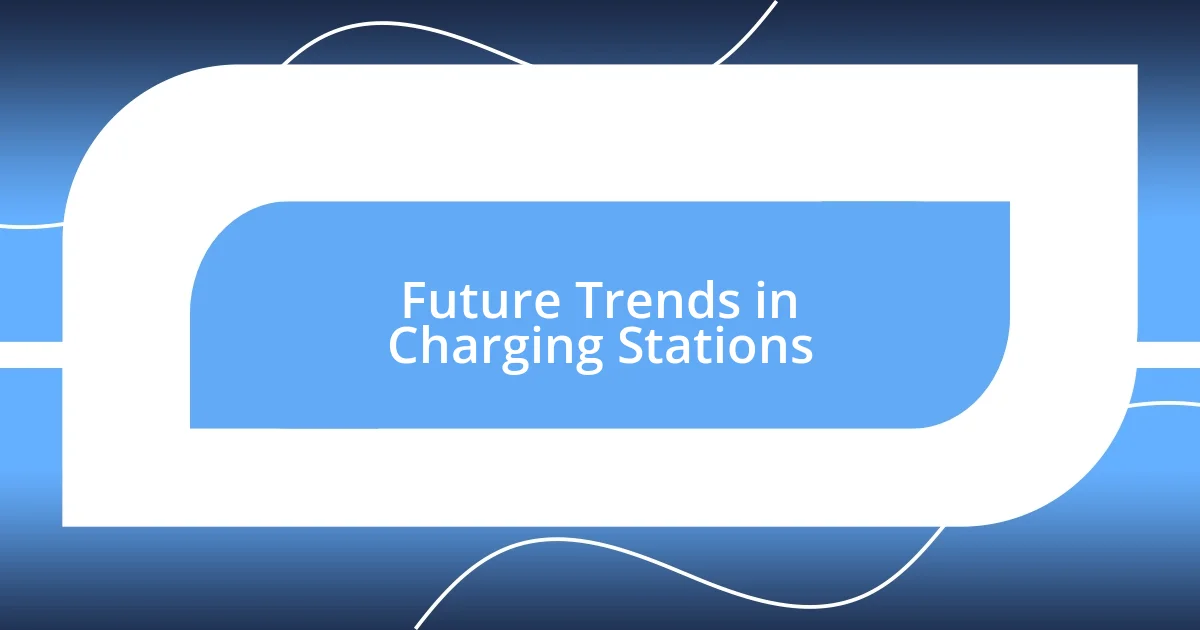Key takeaways:
- Charging stations are crucial for EV infrastructure, with various types (Level 1, Level 2, DC Fast Chargers) catering to different charging needs and speeds.
- Key features of charging stations include user-friendly interfaces, strategic locations, safety measures, and real-time availability of chargers.
- Future trends indicate the potential for ultra-fast charging, integration of renewable energy, and more charging infrastructure in urban areas to enhance EV accessibility.

Overview of Charging Stations
Charging stations have become essential infrastructure as electric vehicles (EVs) gain popularity. I still remember the first time I used a charging station; I was filled with a mix of excitement and uncertainty. Would it really be as simple as refueling a traditional car? To my relief, it was a breeze, and that moment sparked my curiosity about how these stations work and where they are located.
At its core, a charging station allows EV owners to recharge their vehicles safely and efficiently, transforming how we view energy consumption on the road. I often wonder about the variety of charging options available—from standard to fast chargers. It’s fascinating how this diversity caters to different needs and travel habits. For instance, did you know that public fast chargers can recharge a vehicle to 80% in about 30 minutes? It’s incredible how technology can save us time while helping us embrace more sustainable transportation.
The rapid expansion of charging stations speaks volumes about the shift towards greener energy solutions. I’ve seen them pop up in unexpected places, like shopping malls and even remote areas. This growing network not only eases range anxiety for EV drivers, but it also symbolizes a collective effort towards a more sustainable future. Isn’t it thrilling to think that we’re contributing to a cleaner planet, one charge at a time?

Types of Charging Stations
When it comes to charging stations, I’ve discovered a variety of options that cater to different needs and circumstances. Level 1 chargers utilize a standard household outlet and are typically slow, often taking hours to fully charge an EV. I remember waiting at home, watching my neighbor plug in his car, and thinking about how convenient it was, but also how it wouldn’t be practical for long trips.
On the other hand, Level 2 chargers significantly reduce charging times and are often found in public spaces. I recall one weekend getaway where I stopped at a Level 2 charging station while grabbing lunch. In less than an hour, I had enough charge to keep my adventure rolling, showing just how valuable these stations can be for on-the-go charging. Meanwhile, DC Fast Chargers, the fastest option, can charge an EV to 80% in about 30 minutes. I find it amazing how quickly these superchargers work—one time, I barely had time to finish my coffee before I was back on the road, feeling rejuvenated and ready to go.
The diversity among charging stations is pivotal for EV infrastructure. Depending on your location, you might encounter these various types that cater to different circumstances. It’s exciting to think about how this tech fosters a supportive community for electric vehicle users.
| Charging Station Type | Charging Speed |
|---|---|
| Level 1 | 2-5 miles of range per hour |
| Level 2 | 10-20 miles of range per hour |
| DC Fast Charger | Up to 80% in 20-30 minutes |

Key Features of Charging Stations
Charging stations have a blend of essential features that enhance the experience for electric vehicle (EV) owners. One feature that truly stands out to me is the user interface; I’ve encountered stations with touchscreen displays that guide you through the charging process. It’s like having a helpful assistant right there, ensuring you’re never left in the dark. I remember one evening when I approached a charging station that had step-by-step instructions on the screen. It made the process seamless and took away any worries I had about using the equipment.
Additionally, the locations of these stations are strategically chosen. Many stations are placed at convenient spots like shopping centers or near major highways. This accessibility makes long journeys less daunting. If you’re planning a road trip, knowing you’ll find chargers along your route is a relief! Here are some key features I’ve found noteworthy:
- User-friendly interfaces: Touchscreen controls and clear instructions.
- Location convenience: Chargers are often situated in high-traffic areas.
- Charging speed options: Multiple charging speeds tailored for different needs.
- Payment options: Various methods like app-based payments or credit card access.
- Real-time availability: Some stations provide live data on charger availability, alleviating wait times.
The emphasis on safety is another critical feature I’ve seen across many charging stations. After all, when you’re plugging in your vehicle, you want to ensure that both you and your car are in safe hands. I once noticed a station that had clear signage about safety protocols, which gave me a comforting sense of security. It’s these thoughtful details that reinforce the overall reliability of charging stations, making the shift to electric driving even more appealing.

Best Locations for Charging Stations
When I think about the best locations for charging stations, some places just stand out. Imagine pulling into a bustling shopping mall on a Saturday afternoon and finding a charging station right near the entrance. While waiting for my car to charge, I can grab a cup of coffee or do a bit of window shopping. It seamlessly blends the mundane task of charging with the pleasure of shopping—it feels like a win-win!
Another ideal spot I’ve come across is near popular food trucks and parks. I remember enjoying a sunny picnic at my favorite park, and noticing a charging station cleverly positioned nearby. While my friends and I relaxed, I could periodically check on my car from a distance. The convenience of this location made it feel like the station was part of the park experience, rather than just an afterthought.
Having charging stations along major highways cannot be overstated either. I once took a long road trip and made a pit stop at a rest area equipped with fast chargers. It was almost an adventure in itself! I stretched my legs, chatted with fellow EV enthusiasts, and enjoyed a quick snack—all while my car was powerfully charging. Isn’t it great when utility meets comfort? Such strategically placed stations not only reduce range anxiety but also encourage those spontaneous road trips that we all crave.

Factors Affecting Charging Speed
When it comes to charging speed, one significant factor is the type of charger you’re using. I’ve personally switched between Level 1 and Level 3 chargers. The difference? It’s like comparing a trickle of water to a fire hose! Level 1 is just a standard outlet that takes ages, while Level 3, or DC fast charging, can juice up my battery in no time. I remember the first time I tried a fast charger—I was amazed at how quickly I could go from almost empty to a full charge.
The battery’s state of charge also plays a crucial role. I learned this the hard way during a trip where I didn’t plug in until my battery was critically low. Charging at that level took much longer because the fill-up slows down as it approaches full capacity. It’s all about balancing speed and battery health. Ever find yourself wondering why you’re waiting so long at a station? It might be due to how much charge is left in your battery!
Environmental conditions can’t be overlooked either. I once parked at a charging station on a cold winter’s day, and to my surprise, the charging speed lagged significantly. Cold temperatures affect battery performance and can slow down charging. It made me realize that weather really does dictate how quickly I can get back on the road. Have you ever experienced something similar? It’s a reminder of how even the elements can influence our EV journeys.

Cost Considerations for Charging Stations
When it comes to the costs of charging stations, I’ve discovered that initial setup can be a real eye-opener. I remember chatting with a friend who installed a Level 2 charger at home; the upfront investment wasn’t cheap, especially when you factor in permits and installation fees. It can feel overwhelming at first, but I started to realize how much money it could save on fuel in the long run. Have you thought about how much your monthly gas bill is? That perspective really shifted my mindset.
Operational costs also deserve attention. My experience with public charging stations revealed unexpected variances in pricing. Some stations charged by the kWh, while others had flat rates or even free charging options, sending me into a mini-research mode to find the best deals. It’s a bit like hunting for discounts at your favorite grocery store! I often find myself contemplating how these fluctuating costs will impact my travel plans. Should I stick to a budget route, or take the scenic road if it means finding a cheaper charging option?
Finally, let’s not forget about maintenance. While I initially thought once the station is set, it’s all smooth sailing, I quickly learned that wear and tear can add unexpected expenses. I recall a trip where I needed to use a station only to discover it was out of order. I felt that familiar frustration creeping in, much like when you’re late for a meeting due to traffic. It made me wonder—are the costs associated with downtime and maintenance factored into the overall picture? Keeping these considerations in mind helps shape a more realistic understanding of what owning and operating charging stations entails.

Future Trends in Charging Stations
As I look ahead at the future trends in charging stations, one technology that excites me is ultra-fast charging. I had a moment of revelation at an industry event when I learned about advances that could allow EVs to charge in as little as five minutes! Just imagine a world where you could grab a coffee and your vehicle is fully charged by the time you finish—it’s like the fuel stops of old, but so much more efficient. How convenient would that be for our busy lives?
Another trend I see emerging is the integration of renewable energy sources. I recently visited a charging station powered by solar panels, and it struck me how they were harnessing nature to fuel our vehicles. This connection has the potential to revolutionize our approach to sustainability. It also raised the question—will charging stations become hubs for community energy sharing? It sounds promising, doesn’t it?
Lastly, the rise of charging stations in urban environments is something I feel would greatly benefit city dwellers like myself. Picture this: charging stations embedded in parking lots, shopping centers, and even public parks. I remember feeling frustrated when I couldn’t find a nearby station while running errands. If cities can adopt more charging infrastructure, it could not only relieve range anxiety but also promote EV adoption. In a bustling urban landscape, the convenience of charging at every corner could change the way we think about personal transportation. What are your thoughts on this shift?











